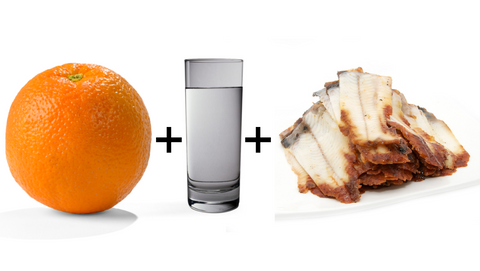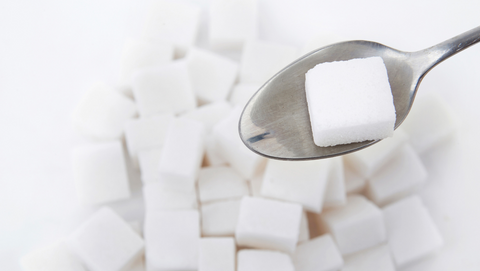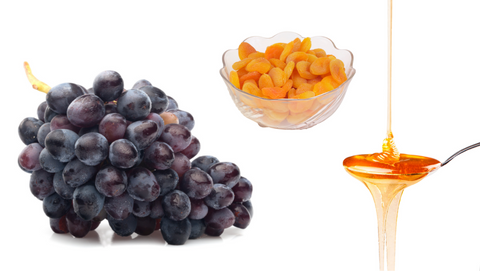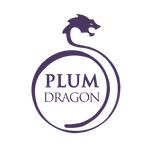Nutrient Timing: Prevent DOMS With Specific Nutritional Protocol
Now that we’ve discussed what you can do to prevent DOMS (delayed-onset muscle soreness) and enhance recovery immediately after training, I want to tell you about how you can use nutrient timing to take advantage of a special window of time that stays open for several hours after each bout of training. This is something that professional trainers use on a regular basis to make sure that the elite athletes in their care bounce back quickly.
After significant and sustained force production, your body is in an altered state with certain specific needs, mostly involving refueling and repairing. To get the most out of what you did, you have to feed it strategically – while it is most sensitive to those needs. If you miss this window, you can still recover, but you’ll have to do it in the slow lane, and it won’t be optimal.
(If you need a reminder of what delayed-onset muscle soreness (DOMS) is, read the first part of this article)
Top Three Ways to Prevent DOMS
You’ve got three things you need to handle right after training if you want to prevent DOMS and squeeze every last benefit out of your hard work:
1. Replenish Your Spent Fuel – All training burns energy, and training with any kind of intensity burns fuel that is stored specifically inside muscle tissues for emergency use. You have to replenish this fuel to be at your best for your next training bout. If you don’t, you rnext performance won’t be able to keep up, and you won’t be able to break your last record. Welcome to plateau-ville.
2. Repair Your Micro-trauma – Effective training triggers a degree of micro-trauma in soft tissues, and this trauma is going to need certain nutrients in order to heal and remodel. Your body only has two places to get its building materials from: either you get it from what you eat, or your body takes it from some other lean tissue inside of you. Since you’re training your whole body to be a strong and balanced weapon, you can’t afford to allow poor nutrition to rob Peter to pay Paul from your muscle tissues.
3. Suppress Your Destructive Stress Hormones – If your training is intense enough and long enough, you’re also going to jack up a nasty stress hormone called cortisol. One of the things cortisol does is break down proteins for energy, including muscle protein, skin and connective tissue collagen. That’s not stuff you can afford to lose on a regular basis either. Why try so hard to build and enhance your tissues if you’re just going to secrete something that comes along and eats it?
And now for the good news: there’s only one thing you have to do in order to accomplish all 3 of these things and effectively prevent DOMS. You need to eat and drink. That’s not so hard. Effective nutrient timing is all about what you eat, when you eat it, and what you avoid:
- Your muscles need blood sugar and water[1] in order to activate and complete the refueling process.
- You need the 8 amino acids found in complete proteins to do the repairs and the remodeling.
- You need to consume both together to trigger a hormonal effect that suppresses tissue-devouring stress hormones, and
- You need it quickly, so you need to get it in you immediately after training, and avoid things that interfere with their absorption into the blood stream and into muscle tissue.
But the devil is in the details, so now I’m going to show you exactly how to do it right, and show you why it’s right.
After Training, Insulin is Your Friend for Preventing DOMS
The hormone responsible for transporting blood sugar and amino acids back into muscles and connective tissues is insulin. Your body keeps tight control over your blood sugar levels, and if you suddenly spike it, your pancreas releases insulin to collect all the excess and haul it into storage.
For several hours after training, your body is in an emergency state, and it’s ready to soak up blood sugar and amino acids like a sponge. If you effectively spike your blood stream with high levels of glucose and amino acids, insulin rushes in to the rescue and delivers all the glucose and amino acids you need to your muscles.
"For several hours after training, your body is in an emergency state, and it’s ready to soak up blood sugar and amino acids like a sponge."
But here’s the rub: if your muscle’s aren’t hungry for it, the only place that sugar can go is into fat tissue. Even the amino acids will be converted into sugar if your body doesn’t feel like it needs them, and then hauled into fat with the rest of the sugar you ate.
So, if you’re sedentary, you don’t want to spike your insulin levels like that. Ever. Not only will you get fatter, but repeated bouts of it will actually decrease your sensitivity to insulin. And, guess which tissue loses its sensitivity first? Muscle. Fat’s insulin receptors hang on for a lot longer, greedily collecting all the sugary handouts long after muscle has closed its doors.
So, if you eats tons of sugars and grains at every meal, you’re going lose your muscle insulin sensitivity. This means that after you train, even if you try to strategically refuel your muscles, they won’t respond to the insulin anymore, and you’ll have trouble refueling and rebuilding properly.
So, please understand, this post-training window for preventing DOMS is an altered state where the normal rules of sensible nutrition don’t apply. The rest of the time, you want to be paying attention to preserving your muscle insulin sensitivity through good nutrition practice of avoiding excess sugar and carbohydrate intake.
If you’re concerned about insulin sensitivity, as anyone eating westernized food ought to be, there’s four things you need to know:
1. Training increases insulin sensitivity – training regularly helps restore insulin sensitivity somewhat because of the state change that occurs in your muscles, so this can serve as a bit of a buffer against bad eating habits (but, come on, let's not rely on this, right?).
2. Immediately after training, muscles can absorb some glucose without insulin – Even if you’ve got some insulin sensitivity issues, you get a "get-out-of-jail-free" card after a good bout of training: your muscles turn on a mechanism called insulin-independent-glucose-uptake, which means just what it says: for a couple hours, you can snag that blood sugar even without the help of insulin. Normally, the doors are closed and that doesn’t happen.
3. Training in a fasted state significantly restores insulin sensitivity. A short, intermittent fast of as little as 12 hours can significantly reset your insulin sensitivity, and drive a lot more of what you eat into your muscles instead of into fat tissue. Just make sure you quickly swallow the post training nutrition you need.
4. Effective nutrition is the only long-term solution – there’s only so much you can do to offset your muscles’ constant insulin bombardment. The only way to fix it is to cut out a lot of the junk, and eat your carbohydrates more sparingly. If you’re a carb lover, the solution is simple: train more often, and eat most of your carbs within 3 hours of training. Problem solved.
Consume Protein, Glucose & H2O Together To Prevent DOMS

It’s essential that you get both complete proteins and glucose-based carbohydrates and lots of water at the same time, without the interference of slowing agents like fat and fiber. [2],[3],[4] This combination triggers a hormone cascade that hauls the protein and carbs you ate right to the site of the damage and doubles the normal rate of remodeling[5],[6],[7] literally altering your genetic expression in order to remodel tissue [8],[9] It rapidly refills those spent fuel tanks, so that you’ll be ready for action faster, with a shot at beating your record again.
"It’s essential that you get both complete proteins and glucose-based carbohydrates and lots of water at the same time, without the interference of slowing agents like fat and fiber."
As a final kicker, the right combination of complete proteins and glucose-based carbs will significantly dampen your cortisol response to training[10], sparing you up to 27% of lean tissues that cortisol would have devoured[11] and significantly reducing your overall soreness. [12]
The Carb Sources That Are Best At Refilling Your Spent Fuel Tanks
The fuel your muscles use for intense and sustained efforts is called glycogen, and it’s a chain of sugar stored right inside the muscle tissue. When it runs low, your body uses its own blood sugar to fill it back up, and there’s only one kind of blood sugar: glucose. Any kind of carbohydrate you ingest has to be converted to glucose before it can flow freely in your blood stream and be used for a refill. So let’s take a look at the different sources of carbohydrates you have to choose from, and see which is best for this.
Grains, Friend or Foe?
Starches, which are the primary form of carbs in grain-based foods like oatmeal, rice, and bread, are just long chains of glucose with fibers in between. Those chains of glucose will break apart into glucose almost immediately unless there are fibers in between them.
The more fiber present in a grain, the slower it will release glucose into your bloodstream. The presence of other foods, particularly fat, also slow down the digestion and release of all nutrients, including the glucose chains in starches.
Wheat is Fast, But …
The fastest grain known for increasing blood sugar is wheat. If that was its only property, I’d be recommending it. But, modern wheat is nothing like the einkorn wheat eaten by our agrarian ancestors. Modern wheat now has so many documented negative effects on metabolism, digestion, mood disorders, and brain function, that I can’t in good conscience recommend it to you, despite its effectiveness in increasing your blood sugar. So leave it on the grocery store shelf.

"Modern wheat now has so many documented negative effects on metabolism, digestion, mood disorders, and brain function, that I can’t in good conscience recommend it to you."
Other starch sources, like rice, oats, potatoes, or quinoa would be a better choice. Organic white rice is a particularly good choice because it digests more quickly than the others but has none of the negative effects of wheat. Just remember, whatever you choose, you need it fast, and grains take a while to cook, so you’d have to have some ready to reheat.
You also want to minimize fat, since it slows everything down, and most people have their grains with butter. Oats with cinnamon and fruits is one way to solve the butter problem, since you’re going the sweet route instead of the fat-and-salty route.
One Sugar You Must Avoid If You Want To Prevent DOMS
There’s one form of sugar that deserve special mention, because it’s a bit of a devil: fructose. This form of sugar doesn’t get converted into glucose at all, so it’s of no use as a recovery agent. Fructose gets processed in the liver, detoxified through the exact same pathway that alcohol uses (that should tell you something) and then gets spit out into the bloodstream as fat, plump and ready for storage.
Fructose also triggers a low energy state at the cellular level, like a light version of what happens to hibernating animals as the winter sets in, along with a number of other negative effects on metabolism. It’s all part of an elaborate anti-starvation system which, of course, is only useful if you’re actually starving. It’s a handy tool if you happen to be fat-depleted in the wilderness, but for everyone else, it’s best to stay away. You aren’t going to break and records or win any fights in a state of semi-hibernation.
Unfortunately, fructose is cheap, so it’s become the sweetener of choice among big food companies, a la high fructose corn syrup. You’ll see high fructose corn syrup in soft drinks and in every sweet thing you can get your hands on, and even not-so-sweet things, like bread, yogurt, and ketchup.
What about Table Sugar?

But don’t let that send you running for the table sugar as an alternative. High fructose corn syrup averages between 45-55% fructose. Table sugar is 1 molecule of glucose and 1 molecule of fructose–in other words, its 50% fructose. So it’s just as bad.
What about Honey, Syrup, and Agave Nectar?
Most health conscious people really slip up here, because in an effort to avoid table sugar and corn syrup, they reach for sweeteners like honey, maple syrup, or agave nectar. Well, guess what...they’re all as high or higher in fructose than high fructose corn syrup. That’s why they’re so sweet. Yeah, all-natural honey has some great nutrients in it, but when it comes to muscle recovery, it’s got nothing to offer you.
Remember, to refuel properly, you need glucose-based carbohydrates.
Why Low Fructose Fruits are Your Best Choice to Prevent DOMS
And that brings us to fruits. Fruits are a near-perfect food for your post-training needs. You don’t have to prepare them, they’re low in fat and low in fiber so they’re quick to digest, they’re full of nutritious goodness, they can be eaten raw with all of their nutrients alive and intact, and they taste great.
The only challenge with fruits is avoiding the ones highest in fructose. I’ve done a little sleuthing for you and looked up the fructose counts in all the common fruits, so I could give you a short list of what to avoid and what to use liberally.

The High Fructose Fruits To Avoid: Dates are far and away the worst when it comes to fructose load. Grapes are second (sorry, I like ‘em too!) followed by pears, apples, and cherries, so avoid all those when you can.
Avoid All Dried Fruits – All dried fruits are way too high in fructose, and drying eliminates a number of important nutrients. So leave out the raisins, prunes, dried figs, dried peaches, and dried apricots.
The Moderate-Fructose Fruits to Use Sparingly – You’ll get moderate levels of fructose from bananas, blueberries, and kiwi. If you use those, use them sparingly.
The Low Fructose Fruits You Can Use Liberally: Your best choices for post workout fruits are pineapples, peaches, oranges, tangerines, clementines, strawberries, plums, and melons. Most of those provide a significant dose of glucose-based sugars with minimal fructose. Plus, they taste great.
Why Protein Bioavailability Should Matter to You
Depending on how their amino acids are chained up, dietary proteins have different levels of bioavailability, which is how much of the protein your body can effectively use. Your body won’t synthesize new proteins unless it has eight essential amino acids all together in a certain ratio. The closer your protein comes to that ratio, the more you benefit.
The egg used to be the gold standard for this. It has a near perfect ratio of all the essential amino acids. The only problem with having eggs after training is that the yolk is very high in fat, and this slows down your digestion. Organic egg whites are a fine choice, but it’s sad to throw away those yolks, which are otherwise packed with nutritious goodness, with some particularly good nutrients like choline that are essential for your nerves and your brain. You don’t want to miss out on those, so I’d recommend having whole eggs and eating them some other time.
The Protein Sources that Are Best At Repairing and Rebuilding Muscle
Your Best Whole-Food Source of Protein
For whole foods, lean pastured meats or wild caught fish have the second highest protein bioavailability. Most grocery stores have smoked salmon that can be eaten immediately, and that’s a fantastic option. If you don’t want that, have something prepared that you can dig into immediately.
Your Best Supplemental Source of Protein
If you’re going to supplement, consider a grass-fed organic whey supplement, or a mixed vegetable protein supplement. Whey protein isolate is the only known protein source to be higher in its bioavailability than egg protein.
If you go this route, make sure you get a source of whey that is pure and unsweetened, not some hyped-up exotic mix with a hundred dubious chemicals in it. Don’t buy into the hype. Plan on making a fruit smoothie with water or organic skim milk and any combination of the low fructose fruits I mentioned. That will hit your bloodstream like lightning.
3 Reasons to Avoid Soy as Your Protein Source
For as much brouhaha as soy has received as a great source of protein for vegetarians and vegans, it really leaves a lot to be desired. Soy’s history of being nutritious came from the east, where they used a traditional crop and then put it through a careful process of fermentation in order to kill off the anti-nutrients and enhance its health benefits.
If you’re doing all that, go ahead and have some, but soy in the west doesn’t get treated that way. Not by a long shot. Western soy is the single most genetically modified food on the market, and all of the soy based protein sources you’re going to get will be of the genetically modified, non-fermented kind.
Its bioavailability is significantly lower than meat, dairy, nuts, and seeds when it comes to protein. It’s also rife with phytoestrogens, which acts like a mimic to the female sex hormone estrogen. That’s not something you want to be putting into your body willy-nilly, especially if you’re a man, unless, of course, your fighting style requires soft skin and man-boobs.
How Much Do You Need?
 As little as 20 grams of protein will be enough to put the initial fire out, but more can often be in order if you aren’t getting enough protein throughout the rest of your day. I’d plan on more, just in case. 6-8 ounces of lean meat (a palm sized serving) will be plenty if you’re not eating like a bird the rest of the day. If you’re using a whey supplement, 1-2 scoops will do.
As little as 20 grams of protein will be enough to put the initial fire out, but more can often be in order if you aren’t getting enough protein throughout the rest of your day. I’d plan on more, just in case. 6-8 ounces of lean meat (a palm sized serving) will be plenty if you’re not eating like a bird the rest of the day. If you’re using a whey supplement, 1-2 scoops will do.
Carbs will depend on your metabolism, how much blood sugar you started with, and how much glycogen you burned out. 30 grams will be enough to get your insulin up. But if you’ve really crushed it hard with a lot of training volume, 60 grams or more may be in order. So enjoy that fruit!
Keep the Jow Flowing
Finally, remember that a liberal supply of dit da jow is one of your greatest secret weapons for a quick and effective recovery. While your diet can provide nutrition to help you win the battle from within, your Jow can also provide nutrition in the hours after training to help win the battle from without as well.









